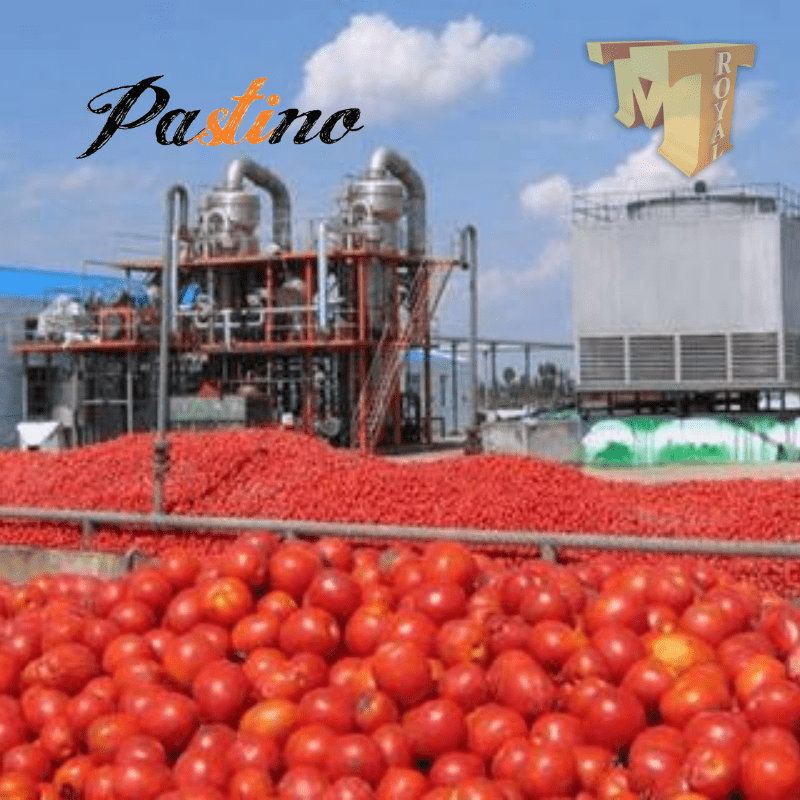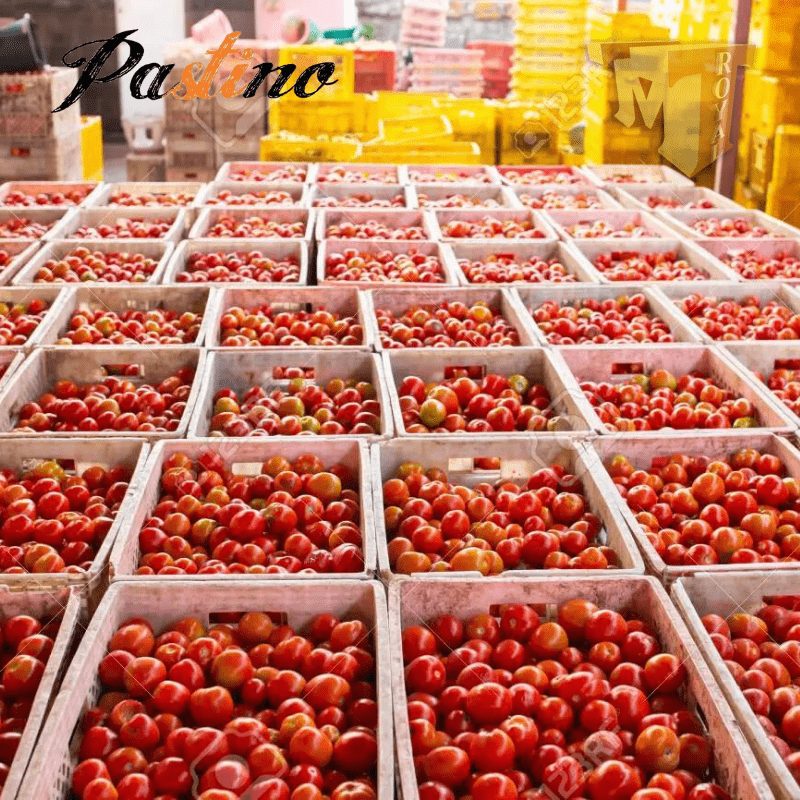Pastino Tomato Paste Production Process
What is the technology of Pastino Tomato Paste
A good quality tomato paste, It can be obtained from fully ripened, healthy and red-coloured tomatoes as much as possible. Therefore, it is of great importance to select varieties suitable for tomato paste production and to grow tomatoes right in the factory. Thus, it is possible to process fresh tomatoes that are not damaged during transportation.
Colour is one of the most important quality criteria of Pastino tomato paste. Therefore, both the skin and the flesh of the tomatoes must be fully fried. Slightly green tomatoes affect the tomato paste colour and flavour very negatively.
The feature of tomatoes to be processed into paste is not limited to colour only. As a matter of fact, these tomatoes; It should be a variety with a high dry matter and sugar content, resistant to diseases and molds, maturing all at the same time and producing abundant products. In our country, various types of tomatoes are grown under the name of “industrial tomato”.
The average dry matter ratio in tomatoes is 5%. The higher the dry matter ratio, the higher the tomato paste yield. However, the dry matter may rise up to a maximum of 6.5%. About 60% of the water-soluble dry matter in tomatoes consists of reducing sugars.
Tomato paste added to foods not only gives them colour and taste, but also makes people perceive the taste better. For this purpose, glutamates are added to many foods in the food industry to provide better perception of taste. Glutamate exists in nature in two different forms, free and bound. Free glutamates are especially abundant in tomatoes and this amount increases with ripening.

Pastino Tomato Paste Production Levels
Pastino Tomato paste production basically consists of 3 stages.
- Obtaining the pulp
- Concentration of pulp at a certain rate
- Filling the tomato paste into the package.
Pulp Production from Tomatoes
It is pulped just like in fruits. Preliminary preparation processes and subsequent production stages are explained below.
- a) Taking the Tomatoes to the Factory
Tomatoes are discharged into the flow channel and transported to the factory with the water in this channel, that is, to the washing machine, which is the first device in the production phase. The flow channel is U-shaped, usually 25-30 cm deep, 30-50 cm wide, made of aluminum or painted sheet metal. The flow channel extends with a slight incline from the raw material platform to the factory and the tomatoes are transported into the factory with the help of the water supplied from the head of the channel. However, the main benefit of the flow channel is that the tomatoes are transported to the plant regularly and a pre-wash is applied by soaking them at the same time.
- b) Washing the Tomatoes
Tomatoes that have been soaked in the flow channel and even pre-washed to some extent are thoroughly washed before being sorted. Modern tomato washing machines consist of two consecutive washing tanks.
- c) Sorting the Tomatoes
A good quality tomato paste can be obtained from good quality tomatoes. It is impossible for all tomatoes from the producer to be perfect. Therefore, sorting tomatoes in tomato paste producing facilities is one of the most important factors on quality. In this way, the amount of mold in tomato paste can be controlled.
Sorting is carried out on a rotating roller belt. After the sorting process is finished, the tomatoes are fully prepared for tomato paste production. So, the quality of Pastino Tomato Paste is because of organic tomatos without any additives. It is %100 Natural and Organic.
- Obtaining Pulp from Tomatoes
peeled tomatoes, It is turned into pulp (tomato juice) at the end of three levels as shredding, heating and thinning the mash. All these three phases take place in a system that works interdependently.
The tomatoes are mashed in a shredding machine and immediately heated, then gradually thinned on the palps. In pulp production, if the smashed tomatoes are heated before going to the pulper, this method is called hot break. If the tomatoes are passed through the rough palper without heating after they are cut and then heated immediately, this method is called cold break.

In the hot processing method, the smashed tomatoes are heated immediately. The pectolytic enzymes, which break down the pectic substances and cause the paste to decrease in consistency, are rendered inactive. In addition, as a result of this heating, vegetable gum substances (gams) in the seed house pass into the tomato paste to a significant extent and a very viscous paste is obtained. Following the shredding, a more viscous tomato paste is produced due to these two reasons as a result of immediate heating. However; Some substances that pass through the beans during heating may cause the tomato paste flavor to take on a slightly bitter quality. Therefore, in the “cold working” method; The smashed tomatoes are first passed through a coarse perforated palper. Thus, the seeds of the tomatoes are separated. The tomatoes are then heated and thinned. During the period between crushing and heating, the natural pectolytic enzymes of tomatoes break down pectic substances at a rate, causing the consistency of the tomato paste to weaken, that is, to gain a more fluid quality. Regardless of how the shredding is done, the obtained mash is immediately heated to a certain temperature between 65-80°C, depending on various factors. Tomatoes can be heated up to 80°C or even higher temperatures provided that the time is kept short. However, if the temperature is too high, the color of the tomato paste turns brown as a result of caramelization.
- Concentrating Pulp into PastinoTomato Paste
The obtained tomato pulp with a brix degree of about 5 (% soluble dry matter) is concentrated in a suitable evaporator. Accordingly, tomato paste; It is a tomato pulp concentrate that has been thinned by separating the core, skin and coarse fibers.

The brix degree of tomato paste is increased to at least 28°. In recent years, highly concentrated tomato paste up to a brix of 46° has been produced and such products are gaining more and more importance. The degree of brix achieved in tomato paste depends on the regulations and standards valid in the domestic market, and on customer requests in the foreign market. In our country, mostly 28-32°brix tomato paste is produced for domestic consumption. Generally, in trade, tomato pastes with 28-30% dry matter are called double concentrates, and those containing 36% dry matter are called triple concentrates. However, in these trade names, it should not be understood that the tomato pulp is concentrated 2 or 3 times. In fact, it is always desirable to concentrate the tomato pulp as much as possible to obtain a viscous product (paste). However, this is not possible due to the natural consistency of the pulp and its increasing consistency in evaporation, and it is not possible to concentrate the tomato paste up to 68-72° brix like fruit juices. After a certain degree of brix, tomato paste becomes such a viscous product that; It becomes impossible to heat the tomato paste without burning it on the evaporator heating surfaces.
Two types of evaporation schemes are very common in tomato paste production. One of them is systems that work intermittently and the other is systems that work continuously. In the discontinuous system, two-stage evaporators are generally used. In these systems, the evaporator in the first stage; It is a tubular evaporator and serves for pre-concentration, where the dry matter of tomato juice is usually raised to 12° brix. Tomato pulp (semi-concentrate) rising to approximately 12° brix in the pre-evaporator is given directly to the steam jacketed evaporators as a second stage. In the tomato paste industry, these simple evaporators are called boules. Steam jacketed evaporators are equipped with mechanical mixers and the product is mixed continuously during evaporation. Continuous evaporators, on the other hand, are mostly tubular evaporators with two or more (3 or 4) stages. Continuous tomato paste evaporators are fully automatic controlled. After the tomato pulp coming to the evaporator reaches the desired concentration, the pulp leaving the system is under automatic control.
Reverse Osmosis Application in Concentrating Pulp into Pastino Tomato Paste

In recent years, reverse osmosis (RO) membrane technique has also been used in tomato paste production to concentrate tomato juice up to a certain dry matter level. The soluble dry matter content of tomato juice is increased from about 5% to 8.5% by passing through reverse osmosis membranes. In this way, approximately 50% of the water that needs to be removed in the first stage of evaporation for tomato paste production is separated without applying heat. Thus, partially concentrated tomato juice is concentrated to 28-30% or 42% dry matter in a conventional evaporator to produce tomato paste.
There are some benefits of including reverse osmosis application in the process of tomato paste production. First of all, since about half of the water that needs to be evaporated in the evaporator is initially separated in the reverse osmosis unit, the evaporator capacity is increased up to 100%. Some problems, especially in old and reduced efficiency evaporators, can be overcome. The sensory properties of tomato paste produced in this way are superior to those of tomato paste produced by the traditional method. In addition, it is claimed that the operating costs are 5-10 times less.
- Filling the Pastino Tomato Paste into the Package
Pastino Tomato paste can be filled in tin cans, glass jars or large volume special plastic bags with aseptic technique. The temperature of the tomato paste is around 60°C at most when it leaves the evaporator. Due to its consistency, heat transfer in tomato paste is extremely poor. For this reason, the possibility of being filled into cans at the current temperature and pasteurized after the cans are closed, as in canned food, is very limited. However; Pasteurization of tomato paste in this way is impossible in large boxes, but possible and even mandatory in very small packages. That’s why the tomato paste taken from the evaporator can be poured into the filling unit and filled into boxes at a temperature of at least 90°C, preferably 93°C, according to the hot filling technique. In this case, there is no need for a pasteurization process. In addition, as in the aseptic filling technique, the tomato paste can be filled after cooling in a tubular heat exchanger. After the tomato paste is filled into the boxes in hot condition, the boxes are immediately closed. While the closed boxes are being transported on the belt, they are turned upside down and continue on their way for 2-3 minutes and then reach the box cooler. When the cans are turned upside down, the lid of the can also comes into contact with the hot tomato paste, and thus the microorganisms in this part are also killed. In some box cooling systems, the boxes do not need to be turned upside down.
It should be especially noted that by filling at 92°-93°C, a certain sterilization is achieved. However, it is imperative that the empty box is sufficiently clean and warm.
As with other canned foods, chlorinated water should be used to cool tomato paste filled cans. Therefore, the water sprayed by atomizing into the boxes in the cooling tunnels should be chlorinated at 3-5 ppm level. In this way, deterioration due to leakage can be significantly reduced.
MT ROYAL Co. Present you the highest quality of Pastino Tomato Paste in Drums and customerization packages with all certificates which you need. For more information and get quote please contact us.






No comment